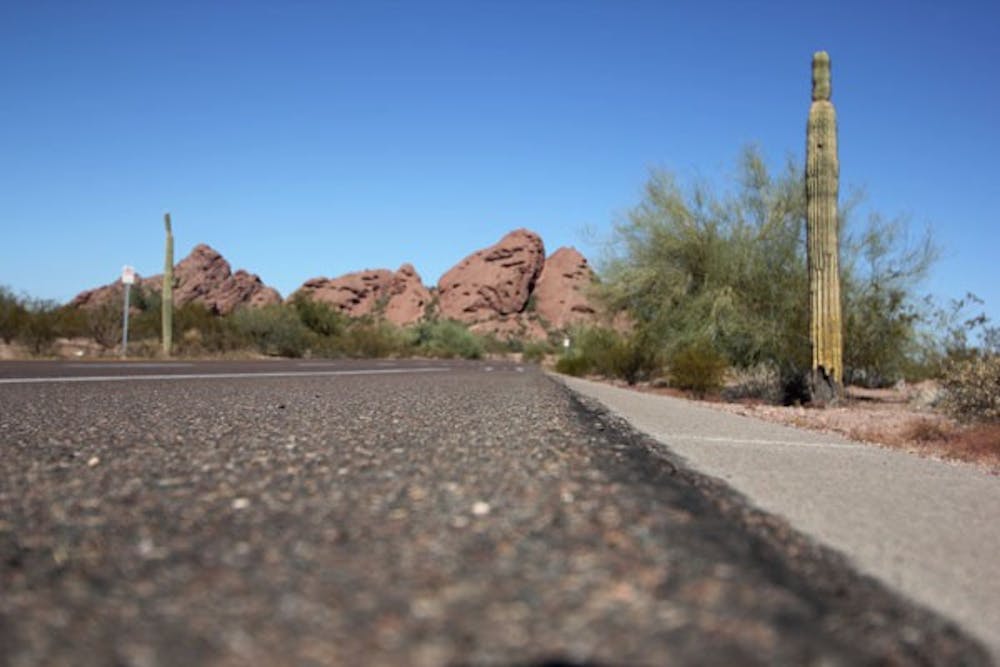 The urban heat island effect could increase summer and night temperatures between 2 and 7 degrees, according to researchers. (Photo by Jenn Allen)
The urban heat island effect could increase summer and night temperatures between 2 and 7 degrees, according to researchers. (Photo by Jenn Allen)Researchers at the Global Institute of Sustainability predict the urban heat island effect will have more repercussions on rising temperatures in the Valley in the coming decades than global warming will.
State climatologist Nancy Selover said the urban heat island effect occurs when irrigated agriculture or natural desert landscape is replaced with concrete, pavement, houses or buildings.
Arizona’s urban areas could see summer temperatures rise between 2 and 7 degrees during the next few decades because of the heat island effect, according to a recent study by the School of Geographical Sciences and Urban Planning and the School of Mathematical and Statistical Sciences.
Selover said building materials conduct and store heat overnight, which causes increased temperatures.
“Now, because of the heat island, we are seeing nighttime temperatures in the low 90s a lot more than we used to,” she said. “The record high at night is 96, and we’re hoping we don’t end up seeing it go above that.”
Selover said the urban heat island effect has been an issue in the Phoenix metropolitan area since development exploded in the 1970s.
“Phoenix is the most studied urban heat island in the world, so we are hoping to apply some of the studies that ASU has done and come up with a model for other desert cities,” she said.
Kena Fedorschak, co-founder of the ASU Honor Society for Sustainability, said people may have known about the heat island effect for many years, but probably don’t think about it as much as they should.
The sustainability and psychology senior said potential solutions for the problem are multifaceted.
“You can reduce the reflectivity of buildings by using white materials and you can also build rooftop gardens or have designated green growing spaces,” he said.
Green spaces help reduce the heat island effect but often draw groundwater unsustainably and Arizonans already use between 200 and 250 gallons of water per day, Fedorschak said.
“We refer to these as wicked problems,” he said. “You solve one thing, but another comes up.”
Senior Sustainability Scientist Nalini Chhetri said Maricopa is the fastest growing county in the country because of the Sun Corridor, a megapolitan area roughly the size of Indiana that extends from north of Phoenix to the Mexican border.
The population of the Sun Corridor, which is roughly equivalent to Indiana’s population, will more than double to nearly 12 million people by 2050, according to independent urban research website America2050.org.
Chhetri said actions such as xeriscaping and planting native desert trees, which require little water but provide much needed shade, can help mitigate the heat island effect as the Sun Corridor grows.
“It’s a combination of technology and lifestyle changes and disseminating knowledge, information and awareness,” she said. “We must not force people to make decisions or give them doomsday scenarios.”
Chhetri said she is optimistic that people will make environmentally sound decisions about urban development if they are well informed and up to date on the most recent environmental studies.
She said the homeless, elderly and low-income populations tend to be the most vulnerable to the heat island effect because they are less likely to have access to air conditioning.
“Adapting to warming temperatures is a function of how we want to live our lives, but if we bog it down in other kinds of ideological debate, we won’t go far,” she said. “Everybody wants energy efficiency. It’s good for the bottom line, the quality of life.”
Temperatures are expected to rise an additional one to four degrees by 2050 from carbon and greenhouse gas emissions, according to a 2012 Southwest Climate Assessment report.
If both effects manifest simultaneously, summertime temperatures could go up between four and 11 degrees. The average high temperature in June and August 2012 was 106 degrees, while July was 104 degrees, according to the Salt River Project’s website.
Reach the reporter at npmendo@asu.edu




